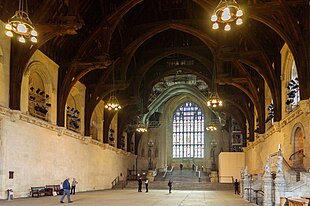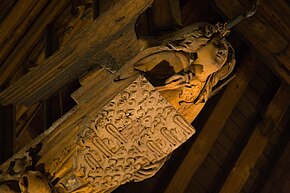Westminster Hall

Westminster Hallis a large medievalgreat hallwhich is part of thePalace of Westminsterin London, England. It was erected in 1097 forWilliam II( "William Rufus" ), at which point it was the largest hall in Europe.[1]The building has had various functions over the years, including being used for judicial purposes from the twelfth to the nineteenth centuries. When ajoint addressis given to the two chambers of the UK Parliament, the House of Commons and House of Lords, the hall is on rare occasions the venue. It is also used for special addresses by Parliament to the Monarch. It was used to hostcoronation banquetsuntil 1821, and since the twentieth century has been the usual venue for thelyings in stateofstate and ceremonial funerals.
The fabric of the hall is particularly notable for itshammerbeam roof,a form typical ofEnglish Gothic architecturewhich uses horizontal trusses to span large distances. The roof was commissioned forRichard IIin 1393 and built by the royal carpenter,Hugh Herland.[2]It is the largest clearspan medieval roof in England, measuring 20.7 by 73.2 metres (68 by 240 ft).[3][4]At the same time the rest of the hall was remodelled by the master masonHenry Yevele.[5]The renovations include eighty-three unique depictions of Richard's favourite heraldic badge, a resting chainedwhite hart.[6]
History[edit]
Westminster Hall has served numerous functions. Until the 19th century, it was regularly used for judicial purposes, housing three of the most important courts in the land: theCourt of King's Bench,theCourt of Common Pleasand theCourt of Chancery.In the reign ofHenry II(1154–89) a royal decree established a fixed sitting of judges in the Hall. In 1215,Magna Cartastipulated that these courts would sit regularly in the Hall for the convenience of litigants.[7]In 1875, the courts were amalgamated into theHigh Court of Justice,which continued to have chambers adjacent to Westminster Hall until moved to the then newRoyal Courts of Justicebuilding in 1882.[8][9]In addition to regular courts, Westminster Hall also housed important state trials, includingimpeachmenttrials and the state trials ofKing Charles Iat the end of theEnglish Civil War,William Wallace,Thomas More,CardinalJohn Fisher,Guy Fawkes,theEarl of Strafford,the rebel Scottish lords of the 1715 and 1745 uprisings, andWarren Hastings.On the night of 10 May 1941 at the height of the Blitz, the Palace of Westminster was showered with incendiary bombs. Scottish politician Walter Elliot happened to be nearby, and directed firefighters to prioritise saving the medieval Hall rather than the Chamber of the House of Commons, whose roof was also alight, and smashed through a door to the Hall with an axe so hoses could be brought in.[10]
The St Stephen's Porch end of the Hall displays under the stained glass window theParliamentary War Memoriallisting on eight panels the names of Members and staff of both Houses of Parliament and their sons killed serving in the First World War; the window itself, installed in 1952, commemorates members and staff of both Houses who died in the Second World War. In 2012, a new stained glass window commemoratingQueen Elizabeth II's diamond jubileewas installed opposite this window, at the other end of the hall.[11]

Westminster Hall has also served ceremonial functions. From the twelfth century to the nineteenth,coronation banquetshonouring new monarchs were held here. The last coronation banquet was that ofKing George IV,held in 1821;[12]his successor,William IV,abandoned the idea because he deemed it too expensive. Since the late 19th century, the Hall has been used as a place forlying in stateduringstateand ceremonial funerals. Such an honour is usually reserved for the Sovereign and for their consorts; the only non-royals to receive it in the twentieth century wereFrederick Sleigh Roberts, 1st Earl Roberts(1914), the 48 victims of the crash of the airship R101 (1930)[13]andWinston Churchill(1965). In 1910 the hall was used for the lying in state ofKing Edward VII,followed byKing George Vin 1936,King George VIin 1952,Queen Maryin 1953,Queen Elizabeth The Queen Motherin 2002, andQueen Elizabeth IIin 2022.[14][15]Around 250,000 mourners filed past the coffin when Queen Elizabeth II lay in state, which resulted in the delamination of the Yorkstone floor.[16]
The two Houses have presented ceremonial Addresses to the Crown in Westminster Hall on important public occasions. For example, Addresses were presented atElizabeth II'sSilver Jubilee(1977),Golden Jubilee(2002) andDiamond Jubilee(2012), the Accession ofCharles III(2022), the 300th anniversary of theGlorious Revolution(1988), and the fiftieth anniversary of the end of the Second World War (1995).
It is considered a rare privilege for a foreign leader to be invited to address both Houses of Parliament in Westminster Hall. Since the Second World War, the only leaders to have done so have been French presidentCharles de Gaullein 1960, South African presidentNelson Mandelain 1996,Pope Benedict XVIin 2010, U.S. presidentBarack Obamain 2011,Burmeseopposition leaderAung San Suu Kyiin 2012, andUkrainianpresidentVolodymyr Zelenskyyin 2023.[17][18][19][20]President Obama was the first US president to be invited to use the Hall for an address to Parliament[21]and Aung San Suu Kyi was the first non-head of state to be given the accolade of addressing MPs and peers in Westminster Hall.
Following reforms in 1999, the House of Commons now uses the Grand Committee Room next to Westminster Hall as an additional debating chamber. (Although it is not part of the main hall, these are usually spoken of asWestminster Hall debates.) In contrast with the two main Chambers, in which the government and opposition benches directly face each other, the seating in the Grand Committee Room is laid out in a U-shape, a pattern meant to reflect the non-partisan nature of the debates there.
Architecture[edit]

The hall is notable for itshammerbeam roof,which was commissioned forRichard IIin 1393.[2]It was built by the royal carpenter,Hugh Herland,and is considered "the greatest creation of medieval timber architecture". creating a single huge open space, with a dais at the end. Richard's master builderHenry Yeveleretained the original dimensions, refacing the walls, with fifteen life-size statues of kings placed in niches.[5]The rebuilding had been begun by KingHenry IIIin 1245, but by Richard's time had been dormant for over a century. Included in Richard's renovations are repetitions of his favourite heraldic badge – awhite hart,chained, and in an attitude of rest – which is repeated eighty-three times, without any of them being an exact copy of another.[6]
The largest clearspan medieval roof in England, Westminster Hall's roof measures 20.7 by 73.2 metres (68 by 240 ft).[3]Oak timbers for the roof came from royal woods inHampshireand from parks inHertfordshireand from that of William Crozier ofStoke d'Abernon,who supplied over 600 oaks inSurrey,among other sources; they were assembled nearFarnham,Surrey, 56 kilometres (35 mi) away.[4]Accounts record the large number of wagons and barges which delivered thejointed timbersto Westminster for assembly.[22]
New Dawn[edit]
New Dawnis a glass artwork byMary Branson,installed in Westminster Hall in 2016. It celebrates the campaign for women's suffrage, and is illuminated with light levels changing according to the tidal level of theRiver Thames.[23][24][25]
References[edit]
- ^Cescinsky, Herbert; Gribble, Ernest R. (February 1922). "Westminster Hall and Its Roof".The Burlington Magazine for Connoisseurs.40(227): 76–84.JSTOR861585.(subscription required)
- ^ab"The hammer-beam roof".UK Parliament.Archivedfrom the original on 30 May 2011.Retrieved28 May2011.
- ^ab"The Palace of Westminster"(PDF).House of Commons Information Office. May 2009.Archived(PDF)from the original on 25 October 2016.Retrieved5 August2010.
- ^abGerhold (1999),pp. 19–20.
- ^abJonathan Alexander & Paul Binski (eds),Age of Chivalry, Art in Plantagenet England, 1200–1400,pp. 506–507, Royal Academy/Weidenfeld & Nicolson, London 1987. Only six of the statues, rather damaged, remain, and the dias has been remodelled, but otherwise the hall remains largely as Richard and his master builder Henry Yevele left it.
- ^abBouell, Charles(1914).Fox Davies, Arthur Charles(ed.).The Handbook to English Heraldry(11th ed.). London: Reeves & Turner. p. 28.
- ^"Early law courts".Archivedfrom the original on 9 June 2020.Retrieved9 June2020.
- ^"Royal Courts of Justice visitors guide".Her Majesty's Courts Service.Archived fromthe originalon 24 July 2010.Retrieved16 May2010.
- ^"Later Law Courts".UK Parliament.Archivedfrom the original on 26 October 2020.Retrieved23 October2020.
- ^Forgotten Scottish hero who saved Westminster Hall from destruction,The Times,2 March 2024
- ^"Unveiling of the Diamond Jubilee window".UK Parliament. 20 March 2012.Archivedfrom the original on 28 October 2016.Retrieved20 October2016.
- ^"Westminster Hall: Coronation Banquets".UK Parliament.Archivedfrom the original on 13 October 2010.Retrieved5 August2010.
- ^"R101 commemorated - UK Parliament".Archivedfrom the original on 31 October 2022.Retrieved31 October2022.
- ^"Lyings-in-State in Westminster Hall".UK Parliament.Archivedfrom the original on 22 January 2021.Retrieved23 February2023.
- ^"The Queen to lie in state in London: everything you need to know".The Guardian.PA Media.12 September 2022.Archivedfrom the original on 17 September 2022.Retrieved17 September2022.
- ^Jones, Tim (29 November 2022)."Mourners filing past the Queen's coffin wore out the stone floor of Westminster Hall".Sky News.Archivedfrom the original on 1 December 2022.Retrieved1 December2022.
- ^"Queen to roll out red carpet for Obamas".Yahoo News. AFP. 22 May 2011. Archived fromthe originalon 24 May 2011.Retrieved25 May2011.
- ^"US President Barack Obama addressing MPs and peers".BBC News. 22 May 2011.Archivedfrom the original on 25 May 2011.Retrieved25 May2011.
- ^"Aung San Suu Kyi calls for UK's support over Burma".BBC News. 21 June 2012.Archivedfrom the original on 23 June 2012.Retrieved24 June2012.
- ^"Zelensky UK visit: Ukrainian leader addressing UK Parliament".BBC News.8 February 2023.Archivedfrom the original on 2023-02-08.Retrieved2023-02-08.
- ^"President Obama: Now is time for US and West to lead".BBC News. 22 May 2011.Archivedfrom the original on 25 May 2011.Retrieved25 May2011.
- ^Salzman, L. F.(1992) [1952].Building in England down to 1540: A Documentary History.Oxford University Press, USA.ISBN978-0-19-817158-4.OCLC758400852.
- ^"Online Exhibition: New Dawn".Heritage Collections.UK Parliament.Retrieved15 February2024.
- ^"New Dawn".Mary Branson.Retrieved15 February2024.
- ^Townsend, Megan (14 June 2016)."Suffragist light sculpture marking women's right to vote battle sets British Parliament aglow".The Independent.Retrieved15 February2024.
- Palace of Westminster
- 1097 establishments in England
- Buildings and structures completed in 1097
- Buildings and structures on the River Thames
- Burned buildings and structures in the United Kingdom
- Grade I listed buildings in the City of Westminster
- Grade I listed government buildings
- Grade I listed palaces
- History of the City of Westminster
- Legislative buildings in the United Kingdom
- Limestone buildings in the United Kingdom
- National government buildings in London
- Official residences in the United Kingdom
- Parliament of the United Kingdom
- Parliamentary Estate
- Rebuilt buildings and structures in the United Kingdom
- Royal residences in the City of Westminster
- Legislative buildings in Europe
- Tourist attractions in the City of Westminster
- World Heritage Sites in London
- William II of England



